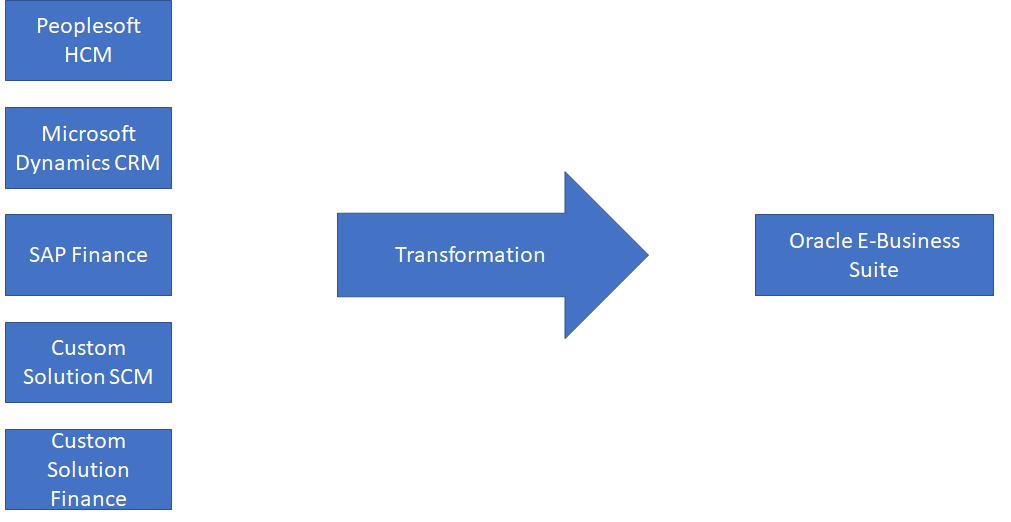Some recent conversations with colleagues on the current ERP landscape in cloud got me thinking. Undoubtedly, evolution of cloud among other things, has significantly impacted the ERP space. We saw more and more customers start their cloud journey by moving their on-prem ERP to cloud infra and then gradually move to SaaS products. There is another interesting trend that has been emerging in the last few years which I want to dwell upon here. What I have noticed is that some of the trends that used to be in vogue about a decade back, are being reversed and this reversal is largely triggered by the evolution of cloud applications. Let me elaborate further
Trend1 -Moving to single ERP suite(then) vs Best of breed cloud products (now)
Past Trend: Multiple ERP products to a single ERP suite
A decade ago, organizations went through transformation to move from disparate products across business functions to a single ERP suite. They would evaluate ERP suites based on fitment to their business processes, and the one suite considered the best fit would be adopted for all or most of the ERP functions, popular among them being Oracle Applications and SAP. There were significant business benefits in consolidating these disparate applications into one single ERP- business could get a consolidated view of their data, rather than having it in silos.

Current Reverse Trend: Single ERP suite to Multiple (SaaS) ERP products
However, now, rather than take a one suite for all approach, customers are increasingly moving towards a hybrid cloud solution where they chose the best SaaS product for each of the business functions. These best of breed SaaS applications are integrated with a PaaS middleware and PaaS intelligence layer that can give them a unified view. This way, they get to choose the best product that fits the business function instead of settling for the entire suite where some business functions need to be force fitted and workarounds or customizations need to be put in place to meet business requirements.

Trend2-Transformation to single global instance and process (then) vs Two-tier ERP (now)
Past Trend: Multiple ERP instances to single global instance
In the past, while transforming their business and application landscape to move into a single global instance, large global organizations also had to adopt a global process which was standardized across geographies and business entities. As part of this transformation, a global process was defined, and individual entities had to follow this global process and the only deviation to the processes were the localizations demanded by statutory requirements.

Current Reverse Trend: Single global instance to multiple ERP
Now, increasingly business is moving towards a two-tier ERP architecture, where the corporate/HQ has its own ERP and the geos/business entities chose to adopt a different ERP, typically best of breed SaaS applications of their own. Individual entities are not forced to follow a global process which may not be best suited for them, instead they get to choose the right process, meeting their goals and adopt best of breed products aligned to their business processes.

Why aren’t the old challenges back with these reverse trends?
While we are going back to the days of data spread across applications and localized processes (as opposed to single ERP suites and global instances), we do not see the old challenges returning. This can be attributed to both the evolution of cloud and low-code-no-code platforms, especially the low-code-no-code integration and intelligence PaaS offerings which have hugely helped in integrating and deriving intelligence out of these poly cloud SaaS applications much more seamlessly.
What are some of the consequences of these new reverse trends in the IT landscape?
Some of the impacts of these trends on the IT estate are –
Reduced customization– With business units getting the autonomy to choose the products best suited for their functions and processes, the need for customization in the ERP space has come down relatively. Most of the times, these extensions are built in a low-code-no-code platform.
Increased need for interfaces– Both the trends we discussed above, have significantly increased the number of applications, compelling the need for automated data flow between the applications leading to more interfaces.
Increased reporting -With data spread across systems, the role of data warehousing and analytics to get a unified picture across systems becomes more prominent.
Wishful thinking for future
While these new trends are leading to an increase in the number of applications in the ERP landscape, and the advancement in PaaS integrations and analytics are ably supporting and enabling data connectedness, there is still scope for improvement.
Ending this note with one idea that in my view will greatly simplify the life of business stakeholders as well as system integrators –
Today, we only have connectors delivered by the product vendors to connect the partner systems, and there is no generic framework to connect different applications.
If every SaaS product provides an open standards-based data exchange capability for A2A (application-to-application) data exchange for both master and transaction data, that would give enterprises the ability to choose the best of breed cloud applications and almost plug and play into their ERP estate. For example, all ERP products should be able to support export and import of AP invoices in a standard format (for e.g. the Peppol format), that way any two SaaS products can be quickly connected to each other without having to spend much time developing interfaces and maintaining them. This would transform the way applications talk to each other and simplify integrations greatly. I hope that we will see this capability in the ERP cloud products in the near future!











